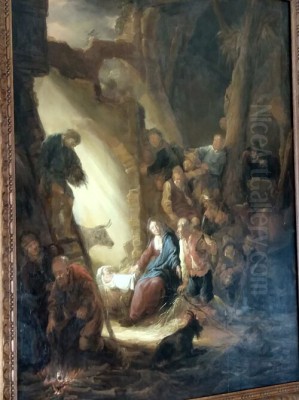
Benjamin Gerritsz Cuyp stands as a distinctive figure within the rich tapestry of Dutch Golden Age painting. Born in Dordrecht in December 1612 and passing away in the same city on August 28, 1652, Cuyp carved out a niche for himself primarily as a painter of landscapes, genre scenes, and religious narratives. Though perhaps overshadowed in popular renown by some contemporaries, his work possesses a unique energy and a dramatic flair, particularly evident in his handling of light and shadow, that secures his place in the annals of seventeenth-century Dutch art.
Early Life and Artistic Formation
Benjamin Gerritsz Cuyp was born into an artistic milieu in Dordrecht, a city with a vibrant cultural life during the Dutch Republic's Golden Age. His father was Jacob Gerritsz Cuyp (1594–1652), himself a respected painter known primarily for portraits but also active in other genres. The artistic lineage extended further back to Benjamin's grandfather, Gerrit Gerritsz Cuyp, who was a notable glass painter and designer. This familial environment undoubtedly provided the young Benjamin with early exposure to artistic practices and materials.
His primary artistic training came directly from his father, Jacob. Under his tutelage, Benjamin would have learned the fundamentals of drawing, composition, and painting techniques prevalent at the time. While Jacob excelled in portraiture, Benjamin's artistic inclinations soon steered him towards different subject matter, favouring the dynamism of genre scenes, the narrative potential of biblical stories, and the atmospheric qualities of landscape, often infused with peasant life or military activities. His formal entry into the professional art world is marked by his joining the Dordrecht Guild of Saint Luke in 1631, an essential step for any artist wishing to practice independently and take on pupils.
The Cuyp Dynasty: Family Ties and Influences
The Cuyp family represents a significant artistic dynasty in Dordrecht. Benjamin's father, Jacob Gerritsz Cuyp, was a versatile artist and a leading figure in the local art scene. Benjamin also had a slightly younger and ultimately more famous half-brother, Aelbert Cuyp (1620–1691). Aelbert, who likely also received initial training from Jacob, would become one of the foremost Dutch landscape painters of the Golden Age, celebrated for his serene, light-filled depictions of the Dutch countryside, often featuring cattle.
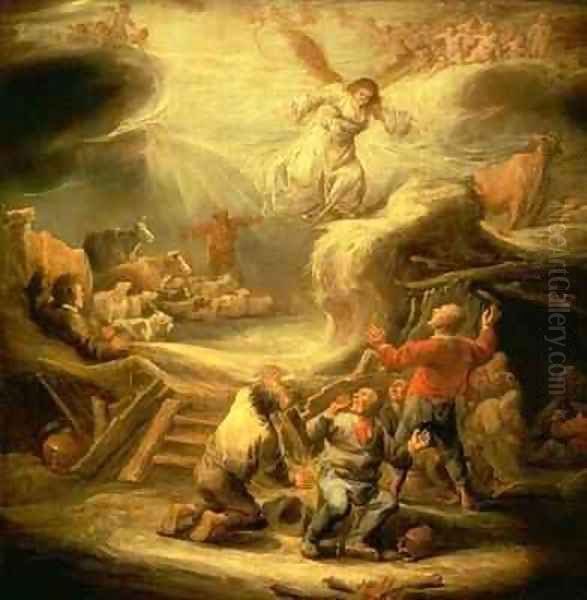
While Benjamin and Aelbert pursued different stylistic paths – Benjamin favouring a more dramatic, often darker, and rougher execution compared to Aelbert's luminous calm – the shared family workshop environment suggests potential for mutual awareness, if not direct influence or collaboration. Benjamin's career largely unfolded during the earlier part of Aelbert's rise to prominence. The artistic household, headed by Jacob, fostered a space where different talents could emerge, contributing significantly to Dordrecht's artistic output.
Artistic Style: Baroque Sensibilities and the Influence of Rembrandt
Benjamin Cuyp's style is firmly rooted in the Baroque. His paintings are characterized by dynamic compositions, energetic brushwork, and, most notably, a dramatic use of chiaroscuro – strong contrasts between light and shadow. This particular aspect strongly suggests the influence of Rembrandt van Rijn (1606-1669), particularly Rembrandt's earlier works from his Leiden period and early Amsterdam years, which were known for their theatrical lighting and emotional intensity.
Although Cuyp masterfully adopted this Rembrandtesque interplay of light and dark to heighten the drama and focus attention within his scenes, there is no documentary evidence to suggest that Benjamin ever studied directly with Rembrandt or had personal contact with the Amsterdam master. The influence appears to have been absorbed through the circulation of Rembrandt's paintings and prints, which were highly sought after and influential throughout the Netherlands. Cuyp adapted these elements into his own distinct, often more rustic and vigorous, visual language.
His subject matter was diverse. Religious scenes, often drawn from the Old and New Testaments, allowed him to explore dramatic narratives and complex figure groupings. His genre paintings frequently depict peasant life – interiors of barns, gatherings in taverns, or outdoor scenes – sometimes reminiscent of the work of Adriaen Brouwer (1605/6–1638) or Adriaen van Ostade (1610–1685), though Cuyp's handling is typically broader and less refined. He also painted battle scenes, military encampments, beach scenes, and allegorical subjects, showcasing a considerable thematic range. His brushwork is often characterized by its speed and sketchiness, contributing to the overall sense of energy and immediacy in his work.
Key Themes and Representative Works
Throughout his relatively short career, Benjamin Cuyp returned to several key themes. Biblical narratives were a significant part of his output. A notable example is his Annunciation to the Shepherds. Works depicting this subject allowed him to fully exploit his mastery of chiaroscuro, contrasting the dark night with the brilliant, divine light emanating from the angel, illuminating the startled shepherds and their flock. These paintings showcase his ability to create dramatic tension and spiritual awe through light effects.
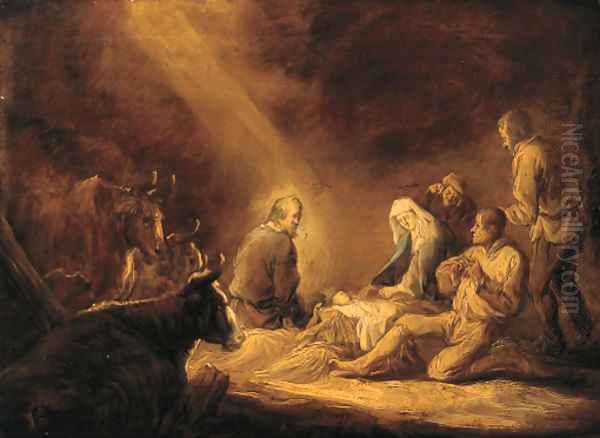
Genre scenes featuring peasants and soldiers were another mainstay. Paintings like Soldiers Building a Fortification capture the rougher aspects of daily life and military activity. These works often feature crowded compositions and earthy colour palettes, rendered with his characteristic vigorous brushwork. They provide valuable insights into the common lives and activities of the period, filtered through Cuyp's unique stylistic lens.
His engagement with Rembrandt's work is evident in pieces like his variations on the theme of Judas Returning the Thirty Pieces of Silver, a subject Rembrandt himself had powerfully depicted. Cuyp's interpretations demonstrate his ability to absorb influential compositions and stylistic devices while reinterpreting them with his own energetic handling.
Another representative work is the Schreibender Orientale (Writing Oriental/Scholar), housed in the Museum Boijmans Van Beuningen in Rotterdam. This painting reflects the Dutch fascination with exotic figures and showcases Cuyp's skill in rendering textures and character through his expressive style. Similarly, works like the Sacra Familia (Holy Family) exemplify his Baroque approach to religious themes, combining dramatic lighting with tender human interaction, rendered in his typical robust manner.
Benjamin Cuyp's works found appreciation during his lifetime and afterwards, entering various collections. Today, his paintings are held by major international museums, including the Stedelijk Museum Amsterdam, the Metropolitan Museum of Art in New York, and the Hermitage Museum in St. Petersburg, attesting to his enduring significance.
Life Beyond Dordrecht and Attribution Challenges
While Benjamin Cuyp spent the majority of his life and career in his native Dordrecht, archival evidence suggests brief periods spent elsewhere. Records indicate he was residing in The Hague in 1643. There is also evidence suggesting activity near Utrecht; specifically, a record of seventeen paintings by him being sold at an auction in Wijk bij Duurstede, a town near Utrecht. This suggests he may have spent time there or had connections to the art market in that region, expanding his professional network beyond Dordrecht.
Like many artists of the period, especially those whose style was distinctive yet perhaps less meticulously documented than the very top masters, Benjamin Cuyp's oeuvre presents some attribution challenges. His energetic, sometimes sketchy style could be imitated, and workshop practices might blur the lines of authorship. There are instances where works once attributed to him have been re-evaluated. For example, a specific painting featuring an angel was historically given to Cuyp but later reassessed, highlighting the ongoing scholarly work required to refine our understanding of his output. These challenges underscore the complexities inherent in studying artists from this period.
Contemporaries and Context in the Dutch Golden Age
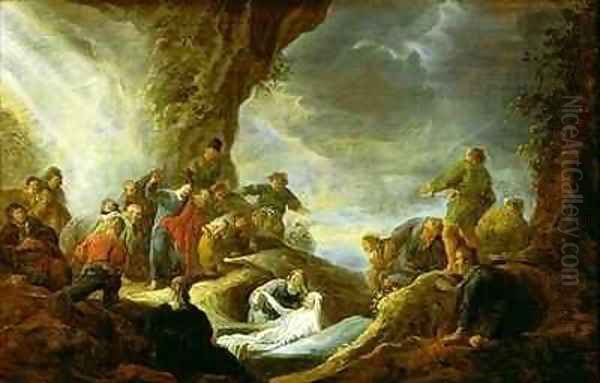
Benjamin Gerritsz Cuyp worked during a period of extraordinary artistic production in the Netherlands. Placing him within this context helps appreciate his unique position. His most immediate artistic connections were his father, Jacob Gerritsz Cuyp, and his half-brother, Aelbert Cuyp. While Benjamin's style differed significantly from both, their shared environment in Dordrecht was crucial. Dordrecht itself fostered other talents, including later Rembrandt pupils like Samuel van Hoogstraten (1627–1678) and Nicolaes Maes (1634–1693), who returned to the city after their time in Amsterdam, contributing to the local artistic dialogue.
Beyond Dordrecht, the towering figure of Rembrandt van Rijn exerted a palpable, albeit indirect, influence on Benjamin's use of light and drama. The broader Dutch art scene was incredibly diverse. In Haarlem, Frans Hals (c. 1582–1666) revolutionized portraiture with his lively brushwork. Genre painting flourished with artists like Jan Steen (1626–1679), known for his humorous and chaotic household scenes, and the aforementioned Adriaen Brouwer and Adriaen van Ostade, who specialized in peasant themes.
In landscape painting, besides his half-brother Aelbert, artists like Jacob van Ruisdael (c. 1629–1682) captured the Dutch landscape with dramatic grandeur, while Paulus Potter (1625–1654) became famous for his detailed depictions of animals in pastoral settings. The meticulous 'fijnschilders' (fine painters) of Leiden, led by Gerard Dou (1613–1675), offered a stark contrast to Cuyp's broader style with their highly polished surfaces and exquisite detail. Meanwhile, in Delft, Johannes Vermeer (1632–1675) explored the subtleties of light and domestic intimacy, and Pieter de Hooch (1629–1684) masterfully rendered interior spaces and courtyards with complex perspectives. Benjamin Cuyp's work, with its rough energy and dramatic flair, offers a distinct voice amidst this constellation of brilliant contemporaries.
Legacy and Reputation
Benjamin Gerritsz Cuyp died relatively young, at the age of 39, limiting the potential full development of his career. He did not achieve the widespread fame or influence of Rembrandt or his own half-brother Aelbert Cuyp. However, his contribution to Dutch Golden Age art is undeniable and significant. He developed a highly personal and expressive style, effectively translating the dramatic potential of Baroque chiaroscuro into scenes of religious narrative, peasant life, and military action.
His energetic brushwork and bold compositions give his paintings an immediacy and raw power that distinguishes them from the more polished works of many contemporaries. He was a key figure in the Dordrecht school of painting during the first half of the seventeenth century, contributing to the city's reputation as an important artistic center. His ability to synthesize influences, particularly from Rembrandt, into a unique artistic vision speaks to his talent and originality.
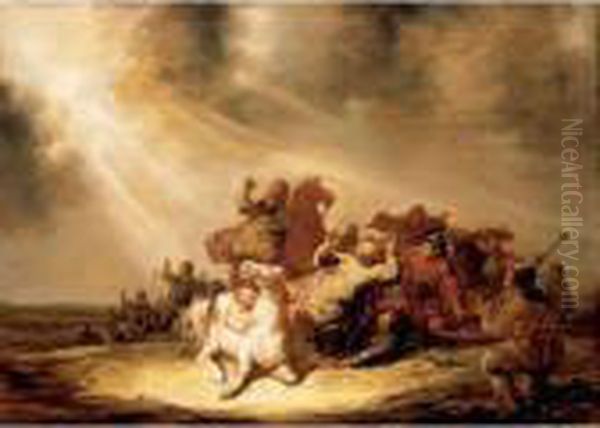
The presence of his works in major museum collections around the world today confirms his historical importance. While perhaps less known to the general public, Benjamin Gerritsz Cuyp is recognized by art historians and connoisseurs as a compelling and distinctive master of the Dutch Golden Age, an artist whose dramatic interpretations of light, life, and faith continue to engage viewers centuries later. His paintings offer a valuable counterpoint to the more serene or highly finished styles often associated with the era, reminding us of the breadth and dynamism of artistic expression during this remarkable period in Dutch history.